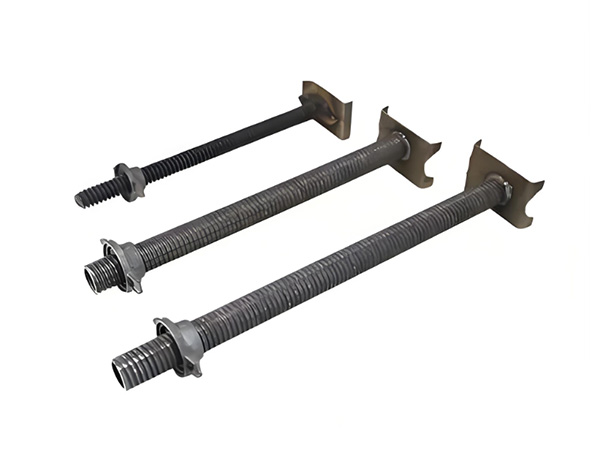- Site Navigation -

Welded Top Support
A Welded Top Support,also known as a welded scaffolding top support,is a specialized load-bearing component used in construction scaffolding and formwork systems.......
A Welded Top Support,also known as a welded scaffolding top support,is a specialized load-bearing component used in construction scaffolding and formwork systems.It consists of a threaded steel rod,a U-shaped top plate(U-head),an adjustment nut,and often a lock nut,with the U-head permanently welded to the threaded rod for enhanced structural integrity.This welded connection distinguishes it from bolted or forged variants,providing superior rigidity for heavy-duty applications.
Key Construction Features
Threaded Rod:Typically manufactured from Q235 or Q345 carbon steel,with diameters ranging from 32mm to 48mm.The rod features coarse trapezoidal threads(ACME profile)with pitches of 4-6mm,allowing for precise height adjustment while maintaining high load capacity.Rod lengths commonly range from 300mm to 1000mm,with hot-rolled or cold-drawn processing for dimensional accuracy.
Welded U-Head:The top plate is formed into a U-shape(inner width 60-100mm)and welded to the rod end using submerged arc welding or gas metal arc welding(GMAW).Weld fillets with minimum leg lengths of 5mm ensure tensile strength exceeding 200MPa.The U-head may include reinforcing ribs(3-5mm thickness)to prevent bending under load,with a base plate thickness of 8-12mm.
Adjustment Mechanism:A hexagonal adjustment nut(cast iron or ductile iron)with anti-slip serrations interfaces with the threaded rod.Some models feature a lock nut(DIN 934 standard)to secure the adjusted position,preventing loosening under vibration.Nut dimensions correspond to rod diameter(e.g.,M36 rod uses M36×4 nut).
Base Connection:The lower rod end may include a square shoulder or threaded section for insertion into scaffold standards,with a minimum insertion depth of 150mm as per EN 12811-1 standards.
Mechanical Performance
Load Capacity:Safe Working Load(SWL)ranges from 3 tonnes to 10 tonnes,with ultimate failure load exceeding 2.5×SWL.Static load testing confirms no permanent deformation under 1.5×SWL for 1 hour.
Weld Strength:The U-head weld undergoes destructive testing to ensure shear strength>150MPa and tensile strength>235MPa,meeting ISO 15614-1 welding procedure qualifications.
Adjustment Range:Vertical travel of 150-600mm,with smooth operation requiring<50N torque for nut rotation.Threads are coated with molybdenum disulfide grease for corrosion resistance and ease of adjustment.
Manufacturing Standards
Complies with EN 74-1(Scaffold fittings)and GB/T 15831(Chinese scaffolding jack standards).Production includes:
Material certification(MTR)verification for chemical composition(C≤0.25%,Mn≤1.4%,P≤0.045%)
Dye penetrant inspection of welds to detect cracks or porosity
Thread gauging(GO/NO-GO)per ISO 1502
Hot-dip galvanizing(Zn coating thickness≥85μm)for corrosion protection,with passivation treatment
Applications
Concrete Formwork:Supporting beam and slab formwork systems,where the welded U-head securely cradles timber joists or steel beams during concrete pouring.
Heavy Construction:Used in bridge construction,high-rise building formwork,and industrial plant maintenance,where dynamic load resistance is critical.
Scaffold Leveling:Compensating for uneven structural members in system scaffolding,providing stable support for working platforms.
Temporary Structures:Supporting stages,grandstands,and event platforms requiring rapid height adjustment and secure load transfer.
Installationu0026 Safety
Pre-installation Check:Verify weld integrity(no cracks,spatter,or undercut),thread condition(no deformation),and coating adhesion.
Insertion:Fully seat the rod into scaffold standards,ensuring minimum embedment depth marked by a witness line.
Adjustment:Rotate nut to achieve required height,using a scaffold spanner(36-48mm socket)for controlled movement.
Locking:Tighten lock nut against adjustment nut with 200-300N·m torque to prevent backspin.
Load Testing:For critical applications,perform pre-loading to 1.2×SWL and monitor for settlement.
Advantages Over Bolted Alternatives
Higher Rigidity:Welded connection eliminates bolted joint play,reducing deflection under dynamic loads by 30-50%.
Faster Installation:No need for bolt tightening or torque verification at the U-head-rod interface.
Cost Efficiency:Lower production labor compared to forged integral designs,while maintaining equivalent strength.
Fatigue Resistance:Continuous material flow at welds improves resistance to cyclic loading in vibrating environments.
Maintenance Requirements
Regular Inspection:Check for weld cracks,thread galling,and zinc coating damage every 6 months in outdoor service.
Lubrication:Reapply anti-seize compound to threads annually to prevent corrosion-induced seizure.
Storage:Keep in dry,covered areas to avoid prolonged exposure to moisture;stack vertically to prevent rod bending.
In summary,the Welded Top Support combines robust construction with precision adjustability,making it a staple in heavy-duty scaffolding applications where structural reliability and load-bearing efficiency are paramount.Its welded design ensures consistent performance under demanding construction conditions,while compliance with international standards guarantees safety and interchangeability.








